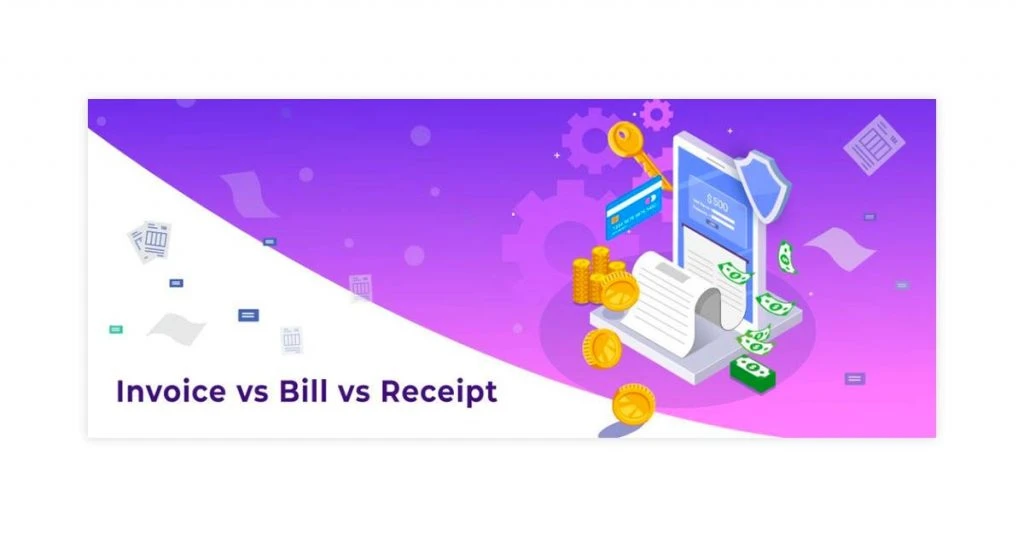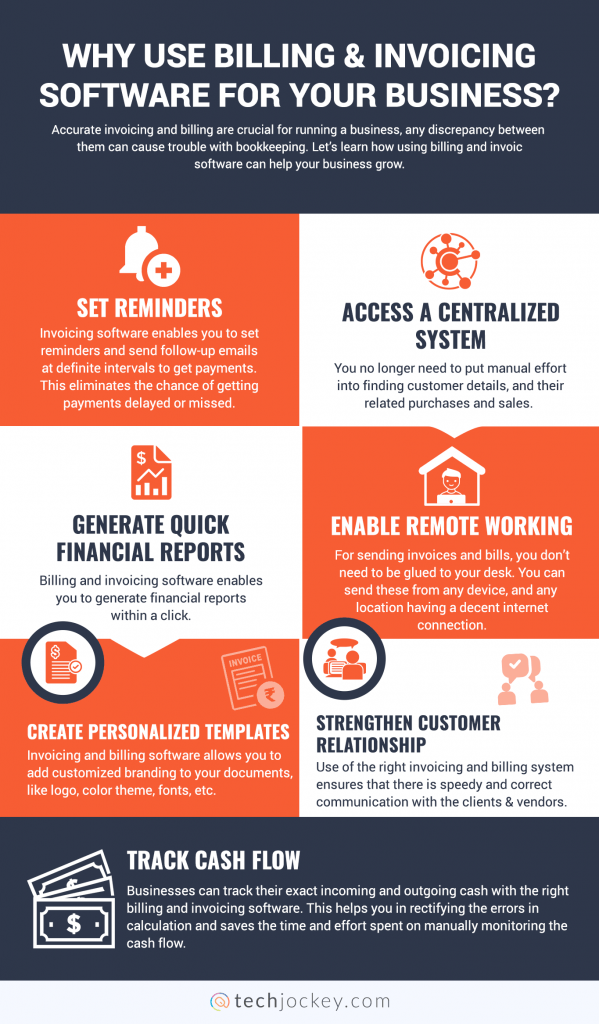Invoice Vs Bill Vs Receipt: What’s the Basic Difference

Invoice, bill, and receipt.
Unknowingly how many times do we use these three terms interchangeably without understanding their basic differences?
A lot, right?
Today, in this article, we’ll understand the subtle differences between these three terms and learn about the importance of using billing and invoicing software for businesses. Let’s check in detail about Invoice Vs Bill Vs Receipt.
What Is an Invoice?
Let’s begin by having a thorough understanding of an invoice.
An invoice is a commercial document that contains an itemized list of sold products and services along with the amount to be paid against it. Invoices act as a legal document issued to the customer before the payment is made. It is shared with the client with an expectation of receiving the due amount within a specific time, like 30 or 90 days.
An Invoice helps businesses:
- Track Payments
- Maintain Sales Records
- Provide Legal Protection
- File Tax Accurately
- Identify Business Trends
What’s Included in an Invoice?
To make sure that your invoice is legally accepted, it should contain the following elements. You can find several invoice templates online that adhere to the basic structure of a professional invoice.

Company Branding: The company logo and the headline ‘INVOICE’ should be prominent in your generated invoice to ease identification.
Invoice Number: Every issued invoice should have a unique invoice number that will help you in keeping clear records and distinguishing between clients.
Dates: The generated invoice should contain all the dates. These include the date on which the invoice was issued, when the products or services were sold, and the due date for payment.
Seller’s Contact Information: The issued invoice should mention the seller’s name, address, and other contact information like phone number and email address.
Buyer’s Contact Information: To be legally sound, the issued invoice should contain the buyer’s information and address.
Terms & Conditions: All the terms and conditions like penalties for late payment, due dates, or partial payments should be clearly mentioned in the invoice itself to ensure 100 percent transparency.
List of Goods and Services: The invoice should have all the line items with a one-line detailing about the product or service.
Additional Charges: Your invoice must have a separate mention for additional charges like tax or freight.
Cost Per Unit: No matter what quantity of products you sell, every line item should have the cost per unit and quantity of goods sold mentioned separately.
Total Amount with Currency: To sum up the invoice, mention invoice price, the total due amount after calculating additional charges along with the currency.
Thank You Note: In the end, add a personalized thank you note, showing gratitude for business collaboration.
Suggested Read: Best GST Billing Software for Small Business in India
What Is a Bill?
A bill is issued to you as a customer for purchasing products or services. It is an invoice that you as a business receive, and enter it as a bill in your books.
You are required to pay the due amount mentioned on the bill to the seller or service provider. The bill is generated to receive instant payment from the customer like restaurant bills, grocery bills, movie ticket bills, etc.
A bill enables a business to:
- Maintain a record of purchases in a particular fiscal year
- Act as a reminder for due payments
- Serve as proof of transaction
What’s Included in a Bill?

A bill should contain the following essential information:
Date of Purchase: A bill should clearly mention the date of purchase, it helps in bookkeeping records.
List of Items: The received bill must contain a list of line items purchased, with cost per unit, and the quantity.
Price: Against every line item, the related price should be mentioned.
Buyer’s Information: This must include the buyer’s name, billing address, email address, and contact number.
Seller’s Information: A received bill should also include the name, address, and contact information of the seller or the service provider.
Payment Methods: A bill should contain mentions of different payment methods in which transactions can be processed.
Warranty/ Guarantee Policies: If your products claim to provide any warranty or guarantee, those should be added to the bill.
Amount to be Paid: The bill should contain separate amounts for specific line items, and the total amount to be paid after all the calculations.
Taxes: A bill should include a specific mention of taxes with the percentage charged.
Signatures: The bill should have the signature of all the parties involved including the buyer, seller, and the notary public, if required.
Suggested Read: Best Free Invoicing Software for Small Businesses
What Is a Receipt?
A receipt is a commercial document that is issued when the payment is received against a bill or invoice. It is proof of the payment received. The receipt can be issued immediately after the payment, or as and when the payment is made.
Receipts work as a:
- Proof of payment for the customer
- Proof of payment completion for the seller
- Sales tracker for the seller
What’s Included in a Receipt?

These are a few standard components that should be added while generating a receipt.
Date of Purchase: The receipt must include the date and time when the purchase was made.
Receipt Number: Every generated receipt should have a unique identification number that must be added to the financial books.
Additional Charges: Any additional charges like tax, installation, or freight should be mentioned separately while issuing a receipt.
Amount Paid: Along with separate line items, the total or partial amount that has been paid should be mentioned in the receipt.
Seller’s Information: The receipt must contain the seller’s contact information like name, address, email, and phone number.
Payment Method: The payment method like cash, UPI, or debit card should be mentioned in the receipt.
Return or Exchange Policy: Terms and conditions for returns and exchange of the product should be mentioned clearly in the receipt. This helps the clients get additional services when required.
Suggested Read: Best Free GST Billing Software – Free Download
Invoice Vs Bill: What’s the Billing and Invoicing Difference
The difference between the invoice and billing document is determined by the position of the sender or the receiver.
So, if you are the vendor and you generate a document that has all the information and pricing regarding the items sold or services rendered, it will be called an invoice. But if the same document you receive as a customer from another seller, it will be called a bill.
For instance, if you are selling headphones, you will generate invoices against the sale for your customers. But if you are buying raw material from your vendor for manufacturing headphones, you will receive a bill against the purchase. Although both the documents require someone to make a payment. In short, an invoice is sent, and a bill is received.
Both the documents help your business to:
- Keep track of sales and purchases
- Maintain clear documentation
- Manage taxes
- Generate accurate financial reports
Invoice Vs Receipt: What is the Difference Between Invoices and Receipts
Invoices and receipts both serve completely different purposes for a business. Both documents are issued at distinct stages in the sales process. An invoice is issued when a business is asking for payment against the products or services sold. While a receipt acts as proof of the payment received.
For example, if you are a software provider, you will send an invoice to your client, asking for payment. But when your client completes the payment, you will issue a receipt to acknowledge the payment.
Generating different invoices and receipts will benefit businesses by eliminating any confusion regarding the payments. An invoice is generated when the payment is initiated by the seller, and a receipt is issued when the payment is completed.
Suggested Read: Best Invoicing and Billing Software Vendors and Companies In India
Bill Vs Receipt: Difference Between Bill and Receipt
The major difference between a receipt and a bill is the purpose and the timing when it is issued. A bill is received when a payment is due, whereas a receipt is received when the payment is completed.
A bill is a detailed document that carries a list of all the line items bought. However, the receipt only carries a summarized amount that is completely or partially paid.
For example, when you receive a monthly telephone, it contains all the information with the numbers dialed, duration of the call, the price charged for the call, etc.
But when you pay the bill, you will receive a concise document that confirms and acknowledges your payment with the amount paid. To sum up, a bill requests payment, while a receipt acknowledges the payment.
People are Also Searching for: Invoice Vs Purchase Order
While differentiating between the documents, invoice vs receipt vs bill, people also searched about the difference between invoice and purchase order.
So, the key difference between a purchase order and an invoice is that the purchase order is generated by buyers and sent to vendors to track the purchasing process. However, an invoice is issued by the vendor and sent to the buyer, requesting payments.
Invoice Vs Bill vs Receipt: Summing Up the Key Differences

Let’s have a quick summary of the key differences between invoice vs bill vs receipt.
| Basis | Invoice | Bill | Receipt |
| Definition | An invoice is a legal document issued to request payments against sold products or services. | A bill is a commercial document received against the purchase of products or services requesting payment. | A receipt is issued upon receiving complete or partial payment against a bill. |
| Purpose | Inform clients about the due payment. | Reminds due payments. | Acknowledges the received payment. |
| Sales Stage | An invoice is issued in the initial stage of the sale. | A bill is issued in the initial stage of the purchase. | A receipt is issued on completion of the sales cycle. |
| Elements | Seller’s and buyer’s information, unique invoice number, sales date, invoice date, and due date, list of all the line items, additional costs, total amount. | Seller’s and buyer’s information, unique bill number, purchase date, bill date, and due date, list of all the line items, additional costs, total amount. | Purchase date, receipt number, payment method, warranty or guarantee terms and conditions, return or exchange policy, payment date. |
| Example | If you are a garment manufacturer, you will issue an invoice for your retailers to request payment. | However, you will receive a bill from your raw material provider, against which you have to make the payment. | Now, when you receive payments from your retailers, you will issue them a receipt to acknowledge them. |
Why Use Billing & Invoicing Software for Your Business?

Accurate invoicing and billing are crucial for running a business, any discrepancy between them can cause trouble with bookkeeping. Let’s learn how using billing and invoice software can help your business grow.
Set Reminders: Invoicing software enables you to set reminders and send follow-up emails at definite intervals to get payments. This eliminates the chance of getting payments delayed or missed.
Access a Centralized System: You no longer need to put manual effort into finding customer details, and their related purchases and sales. Billing and invoicing software offers you a centralized place where you can find all the required information and save time.
Generate Quick Financial Reports: Billing and invoicing software enables you to generate financial reports within a click. These reports and analytics can be used to identify your most sold product, highest paying client, and the peak sales season.
Enable Remote Working: For sending invoices and bills, you don’t need to be glued to your desk. You can send these from any device, and any location having a decent internet connection.
Create Personalized Templates: Invoicing and billing software allows you to add customized branding to your documents, like logo, color theme, fonts, etc. This works as an identification for any document that belongs to your organization.
Strengthen Customer Relationships: Use of the right invoicing and billing system ensures that there is speedy and correct communication with the clients and vendors. This gives a professional approach that leads to long-term collaborations.
Track Cash Flow: Businesses can track their exact incoming and outgoing cash with the right billing and invoicing software. This helps you in rectifying the errors in calculation and saves the time and effort spent on manually monitoring the cash flow.
To Summarize,
Invoice vs bill vs receipt, all work together and are dependent on each other.
Invoice is sent >> Customer receives the bill >> Payment is completed >> Receipt is issued.
Using all these documents correctly on time will help you in managing your business finances efficiently.
FAQs
What is the difference between bill and invoice?
An invoice is issued by the seller to request payment, and a bill is received by the customer to make the due payment.
What is the difference between receipt and bill?
A bill is received against a purchase that asks the buyer to make a due payment, and a receipt is issued as an acknowledgment of the completed payment.
What is the difference between tax invoice and bill?
A tax invoice is issued when the business is registered under GST, and when GST is not applicable on a transaction, a bill is issued.
eInvoice vs eWay bill: what’s the difference?
An eInvoice includes reporting to a government notified portal of all the GST documents to generate a reference number. However, eWay bill is a commercial document that shows that the due GST is paid, and the goods can be transported.
Can an invoice serve as a receipt?
No, businesses should not use invoices and receipts interchangeably. An invoice is generated to request a payment and a receipt is issued when the payment is completed.
Isha’s writing journey started way back in 2018 when she graduated in the field of Journalism & Mass Communication. Since then, she has been writing for all digital and print marketing assets including blogs, editorial reviews, landing pages, emailers, and more. She has contributed her writings to genres... Read more





























